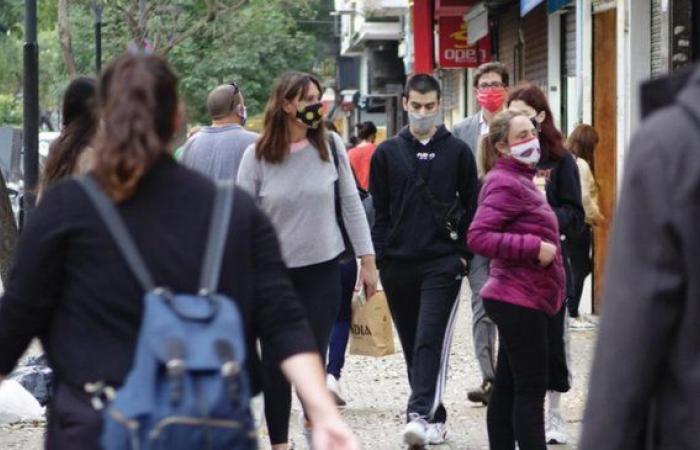“After taking daily walks, I feel more mucus in my nose that interrupts my airways. I don’t have any health problems and I attribute it to something that is in the air,” said Gustavo, a man from La Plata who walks through the Forest every morning. Mirta said the same thing: “The air we breathe feels cloudier and, in some places in the urban area of La Plat, it is perceived as a ‘abombe’”. In line with both testimonies, climate change is a phenomenon that impacts multiple aspects of life on Earth, and among them, its relationship with health is one of the most worrying. Recently, a possible connection has emerged between the increase in carbon dioxide (CO2) and the persistence of pathogens in the air, specifically the SARS-CoV-2 virus, responsible for the COVID-19 pandemic. This association raises the disturbing possibility that climate change could be influencing the transmission of infectious diseases.
In recent weeks, as this newspaper published, it has become common to see the wards full of patients who, for the most part, have headaches, coughs and nasal congestion. Added to this was a notable increase in consultations for pneumonia cases, health system sources agreed.
Diego Bares, head of the Admission Medical Clinic Service at the San Martín General Hospital, had told this medium that “in the last 15 days, both in the public health sector and in the private sector, the persistence of the upper respiratory tract infections, but now something has been added that is much more complex from the biological point of view and the complications that it can generate, which are pneumonia. That is, the involvement of the lower respiratory tract.”
According to what Dr. Silvia González Ayala, an infectious disease specialist from La Plata, stated: “The estimate based on real-world data is that 218 infectious diseases of the 375 listed in the Global Infectious Diseases and Epidemiology Network (GIDEON) English), have worsened. This is the subject of concern and occupation in order to mitigate the effects of anthropogenic climate change on human health. The study is transversal, integrated and transdisciplinary under the concept of a single health: human, veterinary and environmental.” It is not just about the worsening, in addition “there is an increase in the frequency of some diseases related to climate change, dengue is an example,” the specialist continued.
The Pan American Health Organization warns that it is necessary to learn from the Covid pandemic to prepare for the effects of climate change. According to PAHO, “high temperatures, extreme weather events and pollution have caused an increase in cardiovascular and respiratory diseases, as well as an increase in vector-borne diseases.”
THE ROLE OF CARBON DIOXIDE IN THE TRANSMISSION OF SARS-COV-2
As previously published, a recent laboratory study has revealed that increasing concentrations of carbon dioxide (CO2) in the air can prolong the duration during which airborne viruses remain infectious. According to researchers, normal outdoor air has a CO2 level of approximately 400 parts per million (ppm). However, by increasing these concentrations to only 800 ppm, the survival of viruses in the air increases significantly. These findings were published April 25 in the journal Nature Communications.
To avoid a new pandemic, we must focus on prevention rather than cure
The study highlighted that in indoor environments with CO2 levels of 3,000 ppm, which is common in crowded rooms, the amount of infectious viruses after 40 minutes is around ten times higher than in fresh air conditions. This is because CO2 interacts with exhaled droplets, behaving like an acid and allowing viruses to survive longer in the air.
The researchers also noted that climate goals seeking to limit CO2 levels in the atmosphere could have an additional benefit: reducing the spread of airborne viruses. Climate science projects that, without action, the concentration of CO2 in the atmosphere could exceed 700 ppm by the end of the century, which could exacerbate the transmission of viral diseases.
The research showed a correlation between increasing CO2 concentrations and prolonging the time during which the virus remains in the air. This is because CO2 acts like an acid when it interacts with exhaled aerosol droplets, lowering their pH and slowing down virus inactivation.
Pablo Orellano, specialist in epidemiology and CONICET researcher, who pointed out the importance of distinguishing between atmospheric CO2 and indoor CO2. “Atmospheric carbon dioxide is a gas recognized as a greenhouse effect that affects the temperature of the Earth and, in some way, the well-being of people indirectly,” Orellano explained. However, he emphasized that the direct relationship between atmospheric CO2 and human health is not as clear as for other pollutants.
Orellano highlighted that the study from the University of Bristol suggests that CO2 indoors could be directly influencing the risk of contracting a respiratory virus through modifying the pH of the ambient air. Although this hypothesis is being studied, it is not yet completely proven. “Increased carbon dioxide emissions may facilitate conditions for a COVID-like pandemic, but it is premature to hypothesize about that,” he warned.
THE IMPACT OF CLIMATE CHANGE ON HEALTH
Marta Cohen, pediatric pathologist and honorary professor at the Department of Oncology and Metabolism at the University of Sheffield, believes that climate change has an inescapable link with health. Cohen mentioned a study in the United States that suggests that many species, including humans, could change their habitats due to climate change, which would increase opportunities for interaction between humans and wild mammals, facilitating the exchange of viral pathogens.
Cohen stressed that “to avoid a new pandemic, we must focus on prevention rather than cure: we must carry out continuous, detailed and effective epidemiological surveillance.” This surveillance is crucial to detect and control possible new zoonoses, diseases that can be transmitted from animals to humans.
In 2023, a scientific review by the US National Institutes of Health (NIH) noted that climate change has both direct and indirect effects on human health, and some populations are more vulnerable to these effects than others. Viral respiratory infections, such as those caused by SARS-CoV-2, are some of the most common.
Review author Allison Burbank explained that air pollutants, such as nitrogen dioxide and particulate matter, affect susceptibility and immune responses to viral infections. In addition, changes in temperature, humidity and extreme weather events are related to the incidence of respiratory infections. In temperate climates, a lower temperature is generally associated with a higher incidence of infection.
INFECTIONS AND AIR POLLUTANTS
A study from the University of California, San Diego, published in the Canadian Medical Association Journal, established links between the severity of infections and levels of air pollutants. Researchers analyzed more than 150,000 cases of COVID-19 in Ontario, Canada, and found that disease severity was directly associated with long-term exposure to air pollutants such as fine particulate matter and ground-level ozone. .
They seek to mitigate the effects of anthropogenic climate change on human health
Environmental engineer Julieta Vallejo explained that the increase in CO2 in the atmosphere causes a greenhouse effect by “trapping” the heat of the sun, causing a gradual increase in the average temperature of the Earth. This situation has various consequences, such as the greater frequency and intensity of extreme climate events, ocean acidification and changes in the distribution of species. Additionally, greenhouse gases have direct and indirect impacts on human health, including an increase in the spread of diseases due to high temperatures and respiratory problems from air pollution.
Climate change is a multifaceted phenomenon that profoundly affects our health. The possible relationship between the increase in CO2 and the permanence of viruses in the air, such as SARS-CoV-2, highlights the need to better understand how alterations in our environment can influence the transmission of infectious diseases. Prevention and epidemiological surveillance are essential to face future health challenges in a world that continues to warm.
The keys to maintaining a carbon dioxide-free environment
Ventilation
Opening windows and ventilating the room is one of the most effective ways to reduce carbon dioxide levels indoors. Allowing fresh air in dilutes the CO2 concentration and helps maintain a healthy environment.
Natural plants
Using plants such as ferns and palm trees indoors can help absorb carbon dioxide and release oxygen. These plants are especially effective in improving air quality and reducing CO2 in the environment.
Sustainable transport
Using public transportation, bicycles, or walking instead of cars helps reduce carbon dioxide emissions into the outside air. This practice not only reduces pollution, but also promotes a healthier lifestyle.
Air quality
Installing mechanical ventilation systems that filter and supply fresh air from outside is crucial to keeping CO2 levels low in closed spaces. These systems ensure a constant circulation of clean air.
Air Purifiers
An air purifier with an activated carbon filter can be very effective in reducing carbon dioxide in offices and other closed spaces. These devices filter pollutants and improve indoor air quality.






